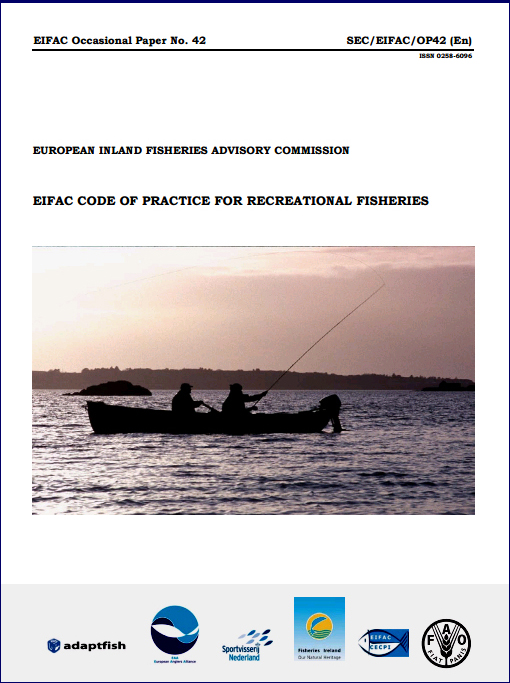 In 2008 EIFAC, the European Inland Fisheries Advisory Commission adopted and published the "EIFAC Code of practice for recreational fisheries".
In 2008 EIFAC, the European Inland Fisheries Advisory Commission adopted and published the "EIFAC Code of practice for recreational fisheries".
The publication is written in English but has a 'non-official translation' annexed - from page 23 onwards: "Code d’usages de la CECPI pour les pêches de loisir".
Some cuttings from the EIFAC Code:
INTRODUCTION
Recreational fishing constitutes the dominant or sole use of many freshwater stocks in the EIFAC region. Its importance is also increasing in economies in transition of that region. Yet little attention has been paid in international policy documents to the responsible management of recreational fisheries. This creates confusion among policy-makers, national and regional bodies, and organizations responsible for fisheries management. As a consequence, the issues faced by this sector are often overlooked or undervalued by policy-makers and in public discussion about the future of the world’s fisheries. The present document aims at addressing this imbalance.
The EIFAC Code of Practice [CoP] for Recreational Fisheries is intended to complement and extend the FAO Code of Conduct for Responsible Fisheries, and is framed specifically towards recreational fisheries practices and issues. It serves as the core document that describes the minimum standards of environmentally-friendly, ethically-appropriate and – depending on local situations – socially acceptable recreational fishing and its management. Although it is clear that many, if not all, of the issues presented in this CoP are already addressed through national fisheries legislation and regional fisheries management regulations in many countries in the EIFAC region, an EIFAC CoP could help make these approaches more coherent. The present CoP is a voluntary instrument adopted and disseminated by the European Inland Fisheries Advisory Commission (EIFAC).
Cuttings from the GLOSSARY (page 20 onwards)
Commercial fisheries:
fisheries whose primary aim is to generate resources to meet nutritional (i.e. essential) human needs; in both full-time and part-time commercial fisheries, fish and other aquatic organisms are sold on domestic and export markets. Commercial fisheries include fisheries that supply feed to the aquaculture and agriculture sectors and raw material to other industrial sectors (e.g. the biomedical sector).
Recreational fishing:
fishing of aquatic animals that do not constitute the individual’s primary resource to meet nutritional needs and are not generally sold or otherwise traded on export, domestic or black markets. The unambiguous demarcation between pure recreational fisheries and pure subsistence fisheries is often difficult. However, using fishing activity to generate resources for livelihood marks a clear tipping point between recreational fisheries and subsistence fisheries. Globally, angling is by far the most common recreational fishing technique, which is why recreational fishing is often used synonymously with (recreational) angling.
Recreational fisheries sector:
the entire network of stakeholders involved in or fully or partly dependent on recreational fisheries including amongst others fisheries ministries and agencies, managers, non-governmental organizations (e.g., umbrella angling associations and clubs), anglers, non-angling recreational fishers, tackle shops and tackle manufacturers, bait suppliers, charter-boating industry, recreational boat builders and chandlery suppliers, marina operators and specialised angling and fishing media, recreational fishing tourism and other related business and organisations as well as all other enterprises supporting recreational fisheries including aquaculture operations that produce stocking material or commercial fishing enterprises that sell angling tickets on their waters. A range of other stakeholders and managerial regimes are not included in this definition though they may run or advocate activities and developments that have a direct impact on the recreational fishing quality and the recreational fisheries sector, the sector’s viability and growth potential (e.g., hydropower generation, water management, irrigation).
Subsistence fisheries:
fishing for aquatic animals that contribute substantially to meeting an individual’s nutritional needs. In pure subsistence fisheries, fishing products are not traded on formal domestic or export markets but are consumed personally or within a close network of family and friends. Pure subsistence fisheries sustain a basic level of livelihood and constitute a culturally significant food-producing and distributing activity.